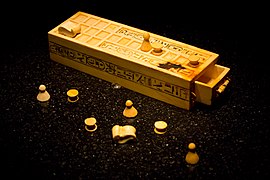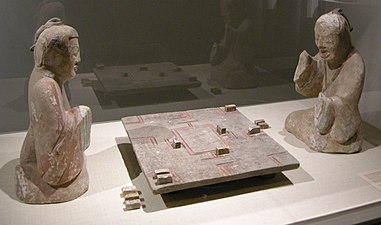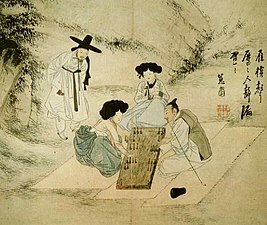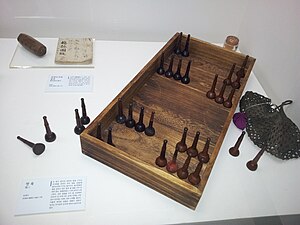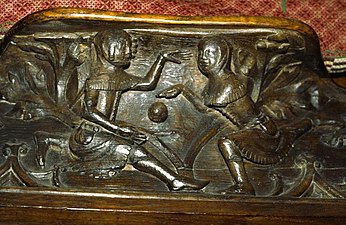History of games
The history of games dates to the ancient human past.[3] Games are an integral part of all cultures and are one of the oldest forms of human social interaction. Games are formalized expressions of play which allow people to go beyond immediate imagination and direct physical activity. Common features of games include uncertainty of outcome, agreed upon rules, competition, separate place and time, elements of fiction, elements of chance, prescribed goals and personal enjoyment.
Games capture the ideas and worldviews of their cultures and pass them on to the future generation. Games were important as cultural and social bonding events, as teaching tools and as markers of social status. As pastimes of royalty and the elite, some games became common features of
In his 1938 book, Homo Ludens, Dutch cultural historian Johan Huizinga argued that games were a primary condition of the generation of human cultures. Huizinga saw the playing of games as something that "is older than culture, for culture, however inadequately defined, always presupposes human society, and animals have not waited for man to teach them their playing".[4] Huizinga saw games as a starting point for complex human activities such as language, law, war, philosophy and art.
Pre-modern
Some of the most common pre-historic and ancient gaming tools were made of bone, especially from the Talus bone, these have been found worldwide and are the ancestors of knucklebones as well as dice games.[5] Dice were invented at least 5,000 years ago and early dice probably did not have six sides.[6] These bones were also sometimes used for oracular and divinatory functions. Other implements could have included shells, stones and sticks.
Middle East and the Mediterranean
Board games likely originate from the ancient Near East, based on archeological findings. A series of 49 small carved painted figures found at the 5,000-year-old Başur Höyük burial mound in southeast Turkey could represent the earliest gaming pieces ever found. Similar pieces have been found in Tell Brak and Jemdet Nasr, but they were isolated.[7] Researches have called the find Dogs and Pigs.[8] The earliest board games were a pastime for the elite and were sometimes given as diplomatic gifts according to a study published in Antiquity.[9] Another possibility is that boards were reserved for the elite, but lower classes played on boards scratched into stone or on the ground. Some archeologists think that stones carved with long rows, dated between 7000 BC and 9000 BC, were used for a mancala-like game.[6]
The earliest known board games all used dice and were for two players.
The
The other example of a board game in ancient Egypt is "
In Ancient Greece and in the Roman Empire, popular games included ball games (Episkyros, Harpastum, Expulsim Ludere – a kind of handball), dice games (Tesserae), knucklebones, Bear games, Tic-tac-toe (Terni Lapilli), Nine men's morris (mola) and various types of board games similar to checkers. Both Plato and Homer mention board games called 'petteia' (games played with 'pessoi', i.e. 'pieces' or 'men'). According to Plato, they are all Egyptian in origin. The name 'petteia' seems to be a generic term for board game and refers to various games. One such game was called 'poleis' (city states) and was a game of battle on a checkered board.[22]

The Romans played a derivation of 'petteia' called 'latrunculin' or
After the

Various games in the
Gallery
-
A Senet game board and game pieces from theKV62 tomb of Tutankhamun— originally from Thebes.
-
Board game with inlays of ivory, rock crystal and glass paste, covered with gold and silver leaf, on a wooden base (Knossos, New Palace period 1600–1500 BCE, Heraklion Archaeological Museum, Crete)
-
Modern reconstruction of the Roman board game Ludus latrunculorum (the bandits' game or the soldier's game), Museum Quintana of Archaeology, in Künzing, Germany
-
Roman statue of a girl playing astragaloi, 150–130 BCE. Berlin, Antikenmuseum.
-
Shatranj set, glazed fritware, 12th century
India
India saw a number of games in ancient period ranging from the various dice games to other board games. The use of cubical and oblong dice was common in the Indus Valley
Another early reference is the

The word 'checkmate' comes from the Persian term in the game, ‘shah mat’, meaning 'the king is dead'.[29] Another game named chaturaji was similar but played with four sides of differing colors instead of two, however the earliest source for this four sided board game is Al-Biruni's 'India', circa 1030 AD. Historians of chess such as Yuri Averbakh have surmised that the Greek board game petteia may have had an influence on the development of early chaturanga. Petteia games could have combined with other elements in the Greco-Bactrian and Indo-Greek Kingdoms.[30][31]
The game of carrom is said to have originated in the Indian subcontinent. Though there isn't any particular proof, it is said that Indian Maharajas invented the game centuries ago. There was a finding of an ancient glass carrom board in Patiala, Punjab. Carrom gained popularity after World War I, and is still a widely popular board game in India.[32]
Adding on, the game of 'Snakes and Ladders', previously known as vaikuntapaali, was originally a Hindu game. It has been speculated that this game was already being played in India as early as the 2nd century AD. Others have credited the invention of the game to Dnyaneshwar (known also as Dnyandev), a Marathi saint who lived during the 13th century AD. This game is also known by names like gyan chaupar (meaning 'game of knowledge) or mokshapat and moksha patamu (both meaning 'way to deliverance').
The game now known as '
The game of
East Asia

The extinct Chinese board game liubo was invented no later than the middle of the 1st millennium BCE, and was popular during the Warring States period (476 BC – 221 BC) and the Han dynasty (202 BC – 220 AD).[41][42] Although the game's rules have been lost, it was apparently a race game not unlike Senet in that playing pieces were moved about a board using sticks thrown to determine movement.
Chinese Chess or Xiangqi seems to have been played during the Tang dynasty, any earlier attestation is problematic. Several Xiangqi pieces are known from the Northern Song dynasty (960–1126). It is unknown exactly how Xiangqi developed. Other traditional East Asian Chess variants include Shogi (Japan) and Janggi (Korea).
The modern game of
The pre-modern Chinese also played
Gallery
-
A pair ofEastern Han dynasty(25–220 AD) ceramic tomb figurines of two gentlemen playing liubo
-
A screen painting depicting people of the Ming dynasty playing Go, by Kanō Eitoku
-
Xiangqi game pieces dated to the Song dynasty (960–1279)
-
Shogi, Go and Sugoroku; Japan, 1780.
-
Players and observers alike absorbed in a Ssangryuk game during the Joseon era.
-
LateJoseon period Ssangnyukboard game set
Africa
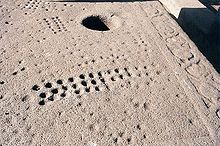
The most widespread of the native African games is
Americas
Archaeologist Barbara Voorhies has theorized that a series of holes on clay floors arranged in c shapes at the Tlacuachero archaeological site in Mexico's Chiapas state may be 5000-year-old dice-game scoreboards. If so this would be the oldest archaeological evidence for a game in the Americas.[55]
One of the oldest known ball games in history is the
The indigenous North American peoples played various kinds of stickball games, which are the ancestors of modern lacrosse. Traditional stickball games were sometimes major events that could last several days. As many as 100 to 1,000 men from opposing villages or tribes would participate. The games were played in open plains located between villages, and the goals could range from 500 yards (460 m) to 6 miles (9.7 km) apart.[57]
Europe
The
Chess was introduced to the Iberian
An important source of medieval games is the
Other pre-modern European board games include
Outdoor games were very popular during holidays and fairs and were played by all classes. Many of these games are the predecessors of modern sports and
Gallery
-
Hnefatafl reconstruction
-
Christian And Muslim playing chess. Libro de los juegos.
-
Wood carving of two youths playing ball on a misericord at Gloucester Cathedral, c. 1350.
-
Italian Sancai Bowl depicting a card game, mid 15th century
-
'Game of Skittles', copy of 1660-68 painting by Pieter de Hooch in the Saint Louis Art Museum
-
Medieval illustration of tabula players from the 13th century Carmina Burana.
Modern games
Professional board games

In 1851, the
A large number of
In
In 1997 the first Mind Sports Olympiad was held in London and included traditional as well as modern board games. Other board games such as Backgammon, Scrabble and Risk are also played professionally with dedicated world championships.
Commercial board games
The Ancient Indian game of
The first board game for which the name of its designer is known is 'A Journey Through Europe or the Play of Geography', a map-based game published in 1759 by
First patented in 1904,
Though the first commercial version of the
Initially designed in 1938, Scrabble received its first mass-market exposure in 1952, two years prior to the release of Diplomacy, in 1954. Diplomacy was a game favored by John F. Kennedy, and Henry Kissinger. Originally released in 1957 as La Conquête du Monde ("The Conquest of the World") in France, Risk was first published under its English title in 1959.
Starting with
A concentrated design movement towards the
.Card games

During the 15th century
The game of
The first documented game of
Collectible card games or trading card games while bearing similarities to earlier games in concept, first achieved wide popularity in the 1990s. The first trading card game was 'The Base Ball Card Game' produced by The Allegheny Card Co. and registered on 4 April 1904. It featured 104 unique baseball cards with individual player attributes printed on the cards enabling each collector to build a team and play the game against another person.[80] The 1990s saw the rise of games such as Magic: The Gathering and the Pokémon Trading Card Game.
Miniature wargaming
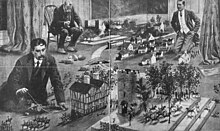
The first non-military wargame rules were developed by Naval enthusiast and analyst
Role playing games

Early role-playing games such as those made by
Other indoor games
In
With the possible exception of carrom (a game whose origins are uncertain), the earliest table games appear to have been the cue sports, which include carom billiards, pool, or pocket billiards, and snooker. The cue sports are generally regarded as having developed into indoor games from outdoor stick-and-ball lawn games (retroactively termed ground billiards),[84] and as such to be related to trucco, croquet and golf, and more distantly to the stickless bocce and bowls.
Outdoor games
Modern
Electronic games
The earliest reference to a purely electronic game appears to be a United States patent registration in 1947 for what was described by its inventors as a "cathode-ray tube amusement device".[85] Through the 1950s and 1960s the majority of early computer games ran on university mainframe computers in the United States. Beginning in 1971, video arcade games began to be offered to the public for play. The first home video game console, the Magnavox Odyssey, was released in 1972.[86][87]
The
References
- ISBN 978-1-4073-0674-2.
- ^ Bakker, Hans T. (2017). The Huns in Central and South Asia. How Two Centuries of War against Nomadic Invaders from the Steps are Concluded by a Game of Chess between the Kings of India and Iran.
- ^ "History of Social Games". Archived from the original on 27 May 2010. Retrieved 24 May 2010.
- ^ Huizinga 1955, p. 1
- ^ Koerper and Whitney-Desautels; Astragalus bones, Artifacts or Ecofacts?, http://www.pcas.org/vol35n23/3523koerper.pdf
- ^ a b c Park, William. "The ancient invention that ignited game play". www.bbc.com. Retrieved 18 October 2022.
- ^ Lorenzi, Rossella (14 August 2013). "Oldest Gaming Tokens Found in Turkey". Discovery News. Archived from the original on 19 August 2013. Retrieved 18 October 2022.
- ^ "Ancient boardgames: Experts find the missing piece (but can't figure out how to play)". Middle East Eye. Retrieved 18 October 2022.
- ^ Viegas, Jennifer (27 November 2012). "Board Games Originated as Elite Pastime : Discovery News". Discovery News. Archived from the original on 15 January 2013. Retrieved 18 October 2022.
- ^ a b Piccaione, Peter A. In Search of the Meaning of Senet Archived 18 September 2008 at the Wayback Machine
- ^ "game-board | British Museum". The British Museum. Retrieved 9 August 2023.
- ^ a b Green, William; Big Game Hunter http://content.time.com/time/specials/2007/article/0,28804,1815747_1815707_1815665,00.html
- ^ "World's Oldest Backgammon Discovered in Burnt City". Payvand News. 4 December 2004. Retrieved 7 May 2010.
- ^ Schädler, Dunn-Vaturi, Ulrich, Anne-Elizabeth. "BOARD GAMES in pre-Islamic Persia". Encyclopædia Iranica. Retrieved 7 May 2010.
{{cite encyclopedia}}: CS1 maint: multiple names: authors list (link) - ^ a b c Hirst, K. Kris. "What? Snakes and Ladders is 4,000 Years Old?". ThoughtCo. Retrieved 23 December 2018.
- ^ "A 4,000-Year-Old Bronze Age Game Called 58 Holes Has Been Discovered in Azerbaijan Rock Shelter". WSBuzz.com. 18 November 2018. Retrieved 23 December 2018.
- .
- ^ "4,000-Year-Old Game Board Carved into the Earth Shows How Nomads Had Fun". Live Science. 10 December 2018.
- ^ "Archaeologists discover 4,000-year-old stone board game". 7 January 2022.
- ^ Metcalfe, Tom (10 December 2018). "16 of the Most Interesting Ancient Board and Dice Games". Live Science. Retrieved 23 December 2018.
- ^ Eli (15 October 2017). "Hounds and Jackals". Ancient Games – Playing the Board Games of the Ancient World. Retrieved 23 December 2018.
- S2CID 163535077. Archived from the originalon 8 April 2009.
- ^ Schädler, Ulrich; Latrunculi, "A forgotten Roman game of strategy reconstructed"; in Homo Ludens. Der spielende Mensch IV, 1994, 47–66.
- ^ Shenk, David. The Immortal Game, page 2006, Anchor Books.
- ^ "Polo | sport". 13 April 2024.
- ^ Christopher Kelly. Theodosius II: Rethinking the Roman Empire in Late Antiquity, Cambridge University Press. 2013. p. 4
- ^ "Touregypt.net". Touregypt.net. Retrieved 25 January 2012.
- ^ Brown, W. Norman; The Indian Games of Pachisi, Chaupar, and Chausar, http://www.penn.museum/sites/expedition/the-indian-games-of-pachisi-chaupar-and-chausar/
- ^ "Iran Chamber Society: Sport in Iran: CHESS, Iranian or Indian Invention?". iranchamber.com. Retrieved 29 May 2020.
- ^ Samsin, M. Pawns And Pieces: Towards The Prehistory of Chess, 2002.
- ^ Averbakh, Y. A History of Chess from Chaturanga to the Present Day, 2012, Russell Enterprises
- ^ "The most popular board games in non-Western cultures". BoardGameTheories. 12 September 2020. Retrieved 1 October 2020.
- ^ Karuna Sharma (2009), A Visit to the Mughal Harem: Lives of Royal Women, South Asia: Journal of South Asian Studies, 32:2, 155–169, DOI: 10.1080/00856400903049457
- ^ Sharma, Harshita (10 March 2021). "Lagori Sports | About | History | Rules & Facts | How to Play". FancyOdds. Retrieved 24 October 2022.
- ^ "Langdi". ULTIMATE FUN ZONE. Retrieved 24 October 2022.
- ^ "Why Gorillas Play Tag".
- ^ "The Evolution Of Kho Kho Mats In India: A Historical Overview". English Jagran. 30 May 2023. Retrieved 6 August 2023.
- ^ Kho Kho, a kabaddi-like sport linked with Indian epic Mahabharata – know all about it Olympics olympics.com
- ^ "kabaddi | sport | Britannica". www.britannica.com. Retrieved 24 October 2022.
- ^ Arasu, S. T. (4 July 2020). "Galah Panjang and its Indian roots". On the sport. Be part of it. Retrieved 24 October 2022.
- ^ Xu, Shen. 說文解字/06 [Shuowen Jiezi vol. 7] (in Chinese). 維基文庫 (Chinese Wikisource). Retrieved 26 June 2009.
簙:局戲也。六箸十二棊也。从竹博聲。古者烏胄作簙。
- ^ Sima, Qian. 史記/卷069 [Records of the Grand Historian vol.69] (in Chinese). 維基文庫 (Chinese Wikisource). Retrieved 26 June 2009.
臨菑甚富而實,其民無不吹竽鼓瑟,彈琴擊築,鬥雞走狗,六博蹋鞠者。
- ^ Potter 1985; Fairbairn 1995
- ^ a b c Brooks 2007
- ^ Potter 1984; Fairbairn 1995
- .
- ^ * Needham, Joseph (1986d), Science and Civilization in China: Volume 5, Chemistry and Chemical Technology, Part 1, Paper and Printing, Taipei: Caves Books, pp. 131–132
- ^ Needham 1986d, p. 328 "it is also now rather well-established that dominoes and playing-cards were originally Chinese developments from dice."
- ^ Needham 1986d, p. 334 "Numbered dice, anciently widespread, were on a related line of development which gave rise to dominoes and playing-cards (+9th-century China)."
- ^ Parlett, David. The Chinese "Leaf" Game at parlett games. Retrieved 9 January 2016.
- ISBN 978-1-59240-208-3.
- ^ Tidwell, Ken. http://www.gamecabinet.com/rules/DominoIntro.html
- ^ Stanwick, Michael and Hongbin Xu From Cards to Tiles: The Origin of Mahjong(g)’s Earliest Suit Names at The Mahjong Tile Set. Retrieved 9 January 2016.
- ISBN 9780802837820. Retrieved 16 August 2018.
- ^ Dell'Amore, Christine; 'Prehistoric Dice Boards Found—Oldest Games in Americas?', [1]
- ISBN 9780061881794. Cf. Chapter 4: "Sudden Death in the New World" about the Ulama game.
- ^ "Lacrosse History". STX. Archived from the original on 24 May 2007. Retrieved 24 February 2007.
- ISBN 0-19-827401-7. LCCN 52-003975 OCLC 1350513, pp.56, 57.
- ^ Murray 1951, p. 56, Helmfrid 2005, p. 2
- ^ Shenk, David. The immortal game, chapter 3, 2006, Anchor Books.
- ^ Sonja Musser Golladay, "Los Libros de Acedrex Dados E Tablas: Historical, Artistic and Metaphysical Dimensions of Alfonso X’s Book of Games" Archived 17 July 2011 at the Wayback Machine (PhD diss., University of Arizona, 2007), 31. Although Golladay is not the first to assert that 1283 is the finish date of the Libro de Juegos, the a quo information compiled in her dissertation consolidates the range of research concerning the initiation and completion dates of the Libro de Juegos.
- ISBN 0-7316-5794-2, p. 67
- ^ Early Playing Cards Research. Trionfi. 2006.
- ^ Shenk, David. The immortal game, 2006, Anchor Books.
- ^ University of Waterloo Games Museum, http://gamesmuseum.uwaterloo.ca/VirtualExhibits/Whitehill/parcheesi/ Archived 6 March 2015 at the Wayback Machine
- ^ Bornet and Burger, Religions in Play: Games, Rituals, and Virtual Worlds, page 95
- ^ Drabble, Margaret; The Pattern in the Carpet: A Personal History with Jigsaws, page 107, 2009.
- ^ A U.S. patent was granted in 1904 but in the autumn of 1902 an article describing the game was published in The Single Tax Review. See http://lvtfan.typepad.com/lvtfans_blog/2011/01/lizzie-magie-1902-commentary-the-landlords-game.html
- ISBN 978-0-19-212998-7.
- ^ "Salvo Is New Game With a Nautical Air". The Milwaukee Journal. 1 July 1931. Retrieved 18 February 2013.
- ^ "German recreation: An affinity for rules?" The Economist, 28 August 2008.
- ISSN 0261-3077. Retrieved 9 August 2023.
- ^ Waddingtons Family Card Games, Robert Harbin, Pan Books Ltd, London, 1972
- ISBN 0-19-869173-4
- ^ Pole, William (1895). The Evolution of Whist. Longmans, Green, and Co. (New York, London), 269 pages.
- ^ The Royal Baccarat Scandal at Tranby Croft Archived 2 April 2012 at the Wayback Machine. 10 July 2011.
- New York Times. 5 June 1891.
- ^ Parlett, David. Poker at parlett games. Retrieved 9 January 2016.
- ^ "World Series of Poker: A Retrospective". Gaming.unlv.edu. 22 October 2007. Retrieved 20 March 2009.
- ^ Sports Collectors Digest (7 April 2000) at 50.
- ^ COSTIKYAN, GREG; The Revolution Began With Paper, 2006, http://www.escapistmagazine.com/articles/view/video-games/issues/issue_42/253-The-Revolution-Began-With-Paper.2
- ISBN 0-7493-0011-6, p120
- ^ Rollin' Bones: The History of Dice, http://www.neatorama.com/2014/08/18/Rollin-Bones-The-History-of-Dice/
- ISBN 978-1-886768-06-2., [page needed]
- ^ US 2455992, Goldsmith Jr., Thomas T. & Mann, Estle Ray, "Cathode-ray tube amusement device", published 1948-12-14, assigned to Allen B. Du Mont Laboratories Inc.
- ISBN 978-1-4283-7647-2.
In 1966, Ralph H. Baer .. pitched an idea .. to create interactive games to be played on the television. Over the next two years, his team developed the first video game system—and in 1968, they demonstrated the "Brown Box," a device on which several games could be played and that used a light gun to shoot targets on the screen. After several more years of development, the system was licensed by Magnavox in 1970 and the first game console system, the Odyssey, was released in 1972 at the then high price of $100.
- ^ Wolverton, Mark. "The Father of Video Games". American Heritage. Archived from the original on 16 February 2010. Retrieved 31 March 2010.


